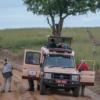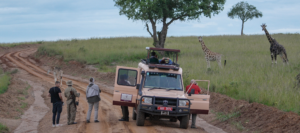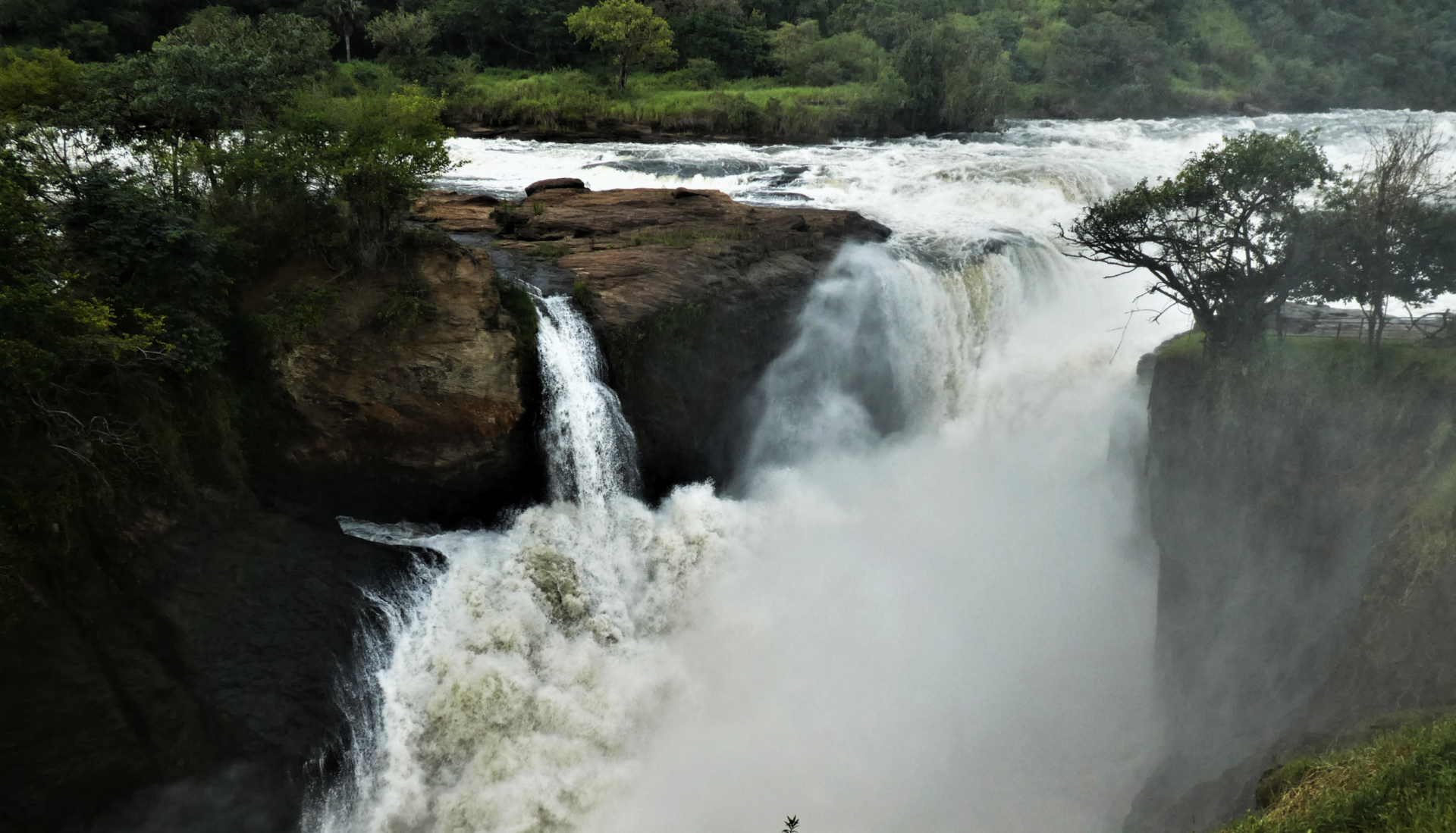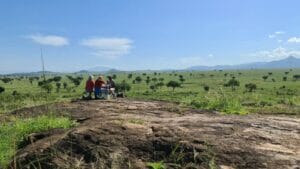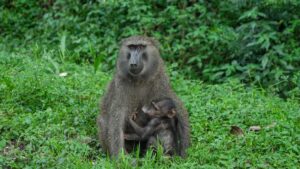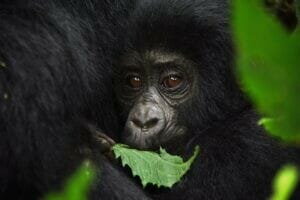Uganda, known as the “Pearl of Africa,” is a treasure trove of incredible wildlife. From majestic elephants to graceful giraffes, this country offers a diverse range of animal encounters. Among its many fascinating inhabitants, the Olive Baboon stands out as a species worth seeking out. In this blog post, we will explore the various national parks in Uganda where Olive Baboons can be found, the best time to spot them, how to safely observe them in the wild, and the importance of sustainable tourism in their conservation.
So, grab your binoculars and get ready for an unforgettable adventure as we delve into the world of Olive Baboons in Uganda!
Understanding the Olive Baboon: Overview and Habitats
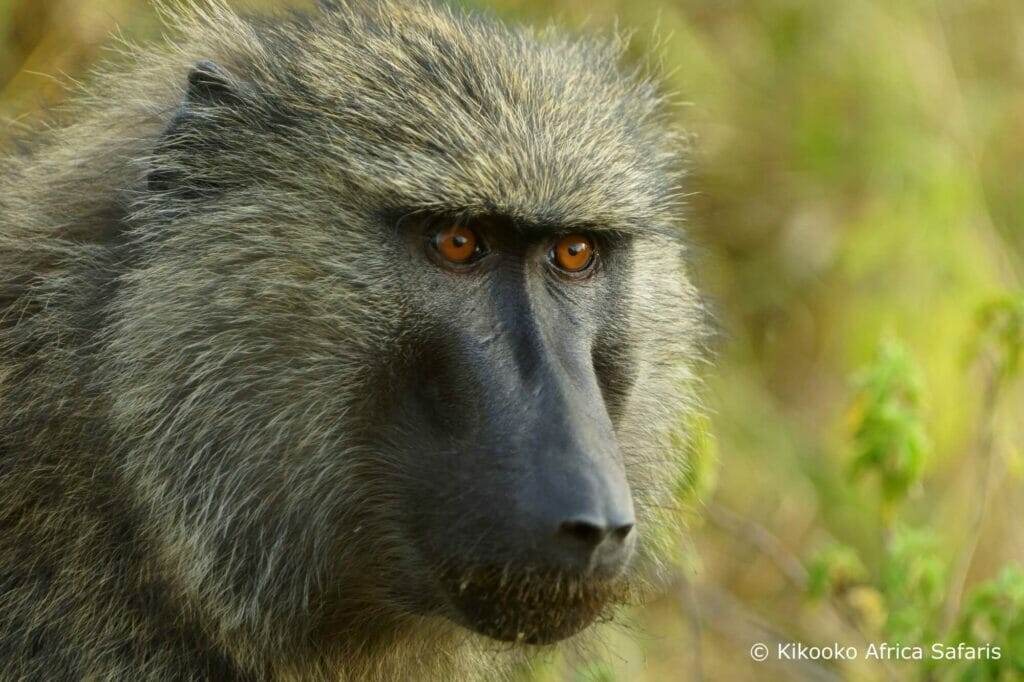
Olive Baboons (Papio anubis) are a species of Old World monkeys that are native to the continent of Africa. They are known for their distinctive olive-colored fur, which gives them their name. These social primates are highly adaptable and can be found in a variety of habitats, including forests, savannas, and even mountainous regions.
Physical Characteristics of Olive Baboons
Olive Baboons are the largest of the baboon species and have an average body length of 2 to 3 feet (60 to 90 cm) and a shoulder height of 20 to 30 inches (50 to 75 cm). Adult males can weigh anywhere between 50 to 100 pounds (23 to 45 kg), while females are slightly smaller, weighing between 25 to 40 pounds (11 to 18 kg). They have a robust build with a long, dog-like snout, a hairless face, and a tail that is not prehensile.
One of the most striking features of Olive Baboons is their olive-greenish fur, which can vary in shade from yellowish-brown to dark gray. They have a hairless face with a prominent muzzle and a patch of bare skin on their buttocks, known as the ischial callosities, which are used for sitting comfortably.
Social Structure and Behavior
Olive Baboons are highly social animals, living in troops that can consist of up to 150 individuals. Within these troops, there is a complex social hierarchy, with dominant males leading the group. Females tend to remain in their natal troops, while males will migrate between troops as they reach sexual maturity.
Baboons are diurnal animals, meaning they are most active during the day. They spend their days foraging for food, grooming each other, and engaging in social interactions. They are omnivorous, with a diet that includes fruits, leaves, seeds, insects, and small mammals. Their strong jaws and sharp canine teeth allow them to consume a wide range of food items.
Distribution and Habitat
Olive Baboons have a wide distribution across Africa, including countries such as Uganda, Kenya, Tanzania, Ethiopia, and Sudan. In Uganda specifically, they can be found in various national parks and protected areas that provide suitable habitats for their survival.
These adaptable primates can thrive in different habitats, including forests, woodlands, grasslands, and even rocky mountainous regions. They are able to tolerate a range of climates, from hot and arid savannas to cooler highland areas. However, they are primarily found in areas with a permanent water source, as water is essential for their survival.
Understanding the natural history and habitat preferences of Olive Baboons is crucial when planning a trip to observe them in the wild. In the following sections, we will explore the national parks in Uganda where these fascinating creatures can be found, allowing you to plan your baboon-watching adventure with confidence.
National Parks in Uganda Where Olive Baboons Can Be Found
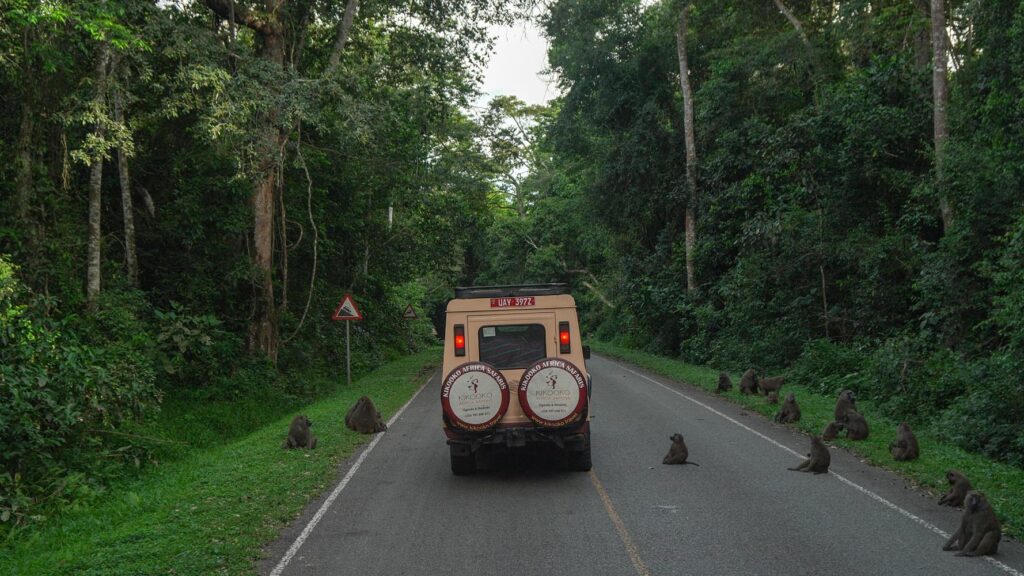
Uganda is blessed with several national parks that provide ideal habitats for Olive Baboons. These parks offer visitors the opportunity to observe these captivating primates up close in their natural environment. Let’s explore some of the prominent national parks in Uganda where Olive Baboons can be found.
Queen Elizabeth National Park
Located in southwestern Uganda, Queen Elizabeth National Park is one of the most popular and diverse national parks in the country. It is home to a wide variety of wildlife, including a thriving population of Olive Baboons. The baboons can be spotted in the park’s savanna grasslands, woodlands, and near the shores of the Kazinga Channel.
Murchison Falls National Park
Situated in the northern part of Uganda, Murchison Falls National Park is the largest and oldest national park in the country. This vast wilderness is home to an abundant array of wildlife, including Olive Baboons. Visitors can find them along the banks of the Nile River, as well as in the park’s woodland areas.
Kibale National Park
Kibale National Park, located in western Uganda, is renowned for its dense tropical rainforest and its impressive population of primates. It is home to a significant number of Olive Baboons, along with other primate species like chimpanzees and red colobus monkeys. The baboons can be observed while trekking through the forest or during guided primate tracking activities.
Lake Mburo National Park
Lake Mburo National Park, situated in the western part of Uganda, offers a unique landscape of rolling hills, open savannas, and acacia woodlands. Although smaller in size compared to other national parks, it is home to a thriving population of Olive Baboons. They can often be spotted near the park’s lakeshores and in the grassy plains.
These national parks provide not only the opportunity to spot Olive Baboons but also to experience the incredible biodiversity and natural beauty that Uganda has to offer. Each park offers a distinct landscape and ecosystem, ensuring a unique baboon-watching experience in every location. So, pack your camera and binoculars as we venture into the heart of Uganda’s national parks to witness the captivating presence of Olive Baboons in their natural habitats.
Best Time to Spot Olive Baboons in Uganda
To maximize your chances of spotting Olive Baboons in Uganda, it is important to consider the best time to observe these fascinating creatures in their natural habitat. Factors such as seasonal patterns, baboon activity, and the time of day can greatly influence their visibility. Let’s delve into the details to determine the optimal time for baboon watching in Uganda.
Seasonal Patterns and Baboon Activity
Uganda experiences two primary seasons: the dry season and the wet season. Understanding the seasonal patterns can help you plan your visit accordingly for the best baboon sightings.
- Dry Season (December to February, May to September): During the dry season, when rainfall is minimal, Olive Baboons tend to concentrate near water sources such as rivers, lakes, and watering holes. With limited water availability, these areas become crucial gathering points for both baboons and other wildlife. The reduced foliage and vegetation during this period also make it easier to spot baboons in the open grasslands and woodland areas.
- Wet Season (March and April, October to November): The wet season brings abundant rainfall to Uganda, resulting in lush vegetation and increased food availability for Olive Baboons. While this can make it slightly more challenging to spot baboons due to the denser foliage, their activity levels tend to be higher during this time as they forage for fruits, leaves, and insects. Additionally, the wet season offers a unique opportunity to witness baboons engaging in social behaviors, such as grooming and playing.
Time of Day for Optimal Baboon Watching
The time of day can significantly impact the visibility and behavior of Olive Baboons. Consider the following factors when planning your baboon-watching activities:
- Early Morning: Baboons are generally most active in the early morning hours, shortly after sunrise. During this time, they are often seen foraging for food, socializing, and moving within their troop. The calm and cooler temperatures of the morning also make it an ideal time to observe their behavior.
- Late Afternoon: Another favorable time for baboon sightings is in the late afternoon before sunset. As the day cools down, baboons become more active again, preparing for their evening activities. This is a great time to witness their interactions, such as grooming sessions or playful behaviors.
It’s important to note that baboon activity can vary, and there is no guarantee of sightings at any specific time. However, by considering the seasonal patterns and the time of day, you can increase your chances of observing Olive Baboons in their natural environment during your visit to Uganda.
How to Safely Observe Olive Baboons in the Wild
Observing Olive Baboons in the wild can be a thrilling and rewarding experience. However, it is essential to prioritize their safety and well-being, as well as your own. Here are some guidelines and safety tips to ensure a responsible and enjoyable baboon-watching experience in Uganda.
Guidelines for Baboon Watching
- Maintain a Respectful Distance: It is crucial to observe baboons from a safe distance to avoid disturbing their natural behavior. Keep a minimum distance of at least 20 meters (65 feet) from the baboons, especially if they are with young infants. This helps prevent any potential aggression or stress to the animals.
- Stay Quiet and Calm: Baboons are sensitive to noise and sudden movements. Maintain a quiet and calm demeanor while observing them. Avoid making loud noises or sudden gestures that may startle or agitate the baboons.
- Observe, but Do Not Touch: Baboons are wild animals, and it is important to remember that they should not be approached or touched. Respecting their space helps maintain their natural behavior and reduces the risk of any conflicts or injuries.
- Do Not Feed the Baboons: Feeding baboons is strictly discouraged. Human food can be harmful to their health and disrupt their natural foraging behavior. It can also lead to baboons becoming dependent on handouts from humans, which can be detrimental to their survival in the wild.
- Follow Park Regulations: Each national park in Uganda may have specific guidelines and regulations for wildlife observation. Familiarize yourself with these rules and regulations and ensure that you adhere to them at all times.
Safety Tips and Precautions
- Stay in Designated Viewing Areas: Stick to designated trails, viewpoints, or observation points within the national parks. Venturing off the marked paths can not only put you at risk but can also disturb the baboons and their habitat.
- Maintain a Safe Distance from Baboon Troops: While observing baboons, be cautious of their behavior and body language. If you notice any signs of aggression, such as baring of teeth, loud vocalizations, or charging, slowly move away to a safer distance.
- Protect Your Belongings: Baboons are known to be curious and opportunistic, so it is important to secure your belongings. Keep your bags, food, and any other items safely stored to prevent baboons from approaching and potentially causing damage or taking them.
- Follow the Guidance of Park Rangers and Guides: When visiting national parks in Uganda, it is recommended to engage the services of experienced park rangers or local guides. They have extensive knowledge about the behavior of baboons and can provide valuable insights and ensure your safety during the observation.
By following these guidelines and safety tips, you can enjoy the beauty and wonder of watching Olive Baboons in their natural habitat while minimizing any potential disturbances or risks to both the baboons and yourself. Responsible and ethical baboon-watching practices contribute to the conservation and preservation of these magnificent creatures for future generations to appreciate.
Get Ready To Find Olive Baboons in Uganda with Kikooko Africa Safaris
As you conclude your baboon-watching journey, reflect on the impact your visit has had on raising awareness, supporting conservation efforts, and leaving a positive footprint on the environment. Let your experience inspire others to appreciate and protect the magnificent Olive Baboons of Uganda for generations to come.
Experience East Africa by booking a safari with Kikooko Africa Safaris, a locally owned and operated safari company based in Uganda.


